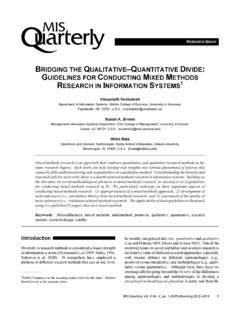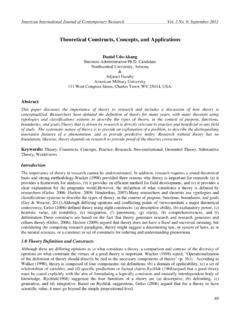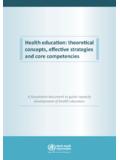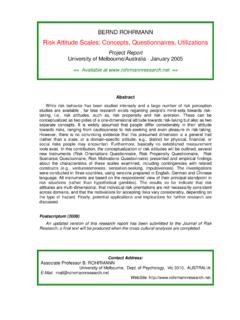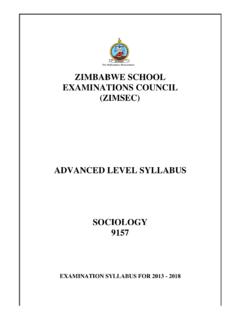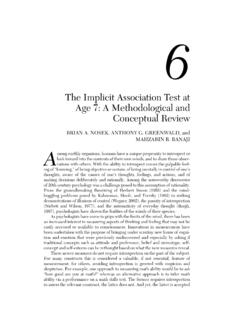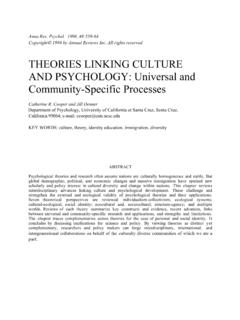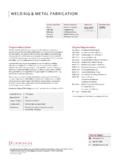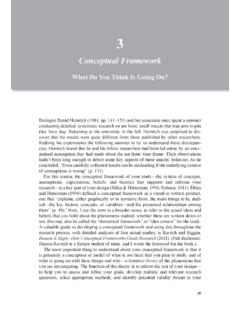Transcription of M APPLICATION USABILITY CONCEPTUALIZATION …
1 RESEARCH ARTICLEMOBILE APPLICATION USABILITY : CONCEPTUALIZATIONAND INSTRUMENT DEVELOPMENT1 Hartmut Hoehle and Viswanath VenkateshDepartment of Information Systems, Sam M. Walton College of Business, University of Arkansas,Fayetteville, AR 72701 paper presents a mobile APPLICATION USABILITY CONCEPTUALIZATION and survey instrument following the 10-step procedure recommended by MacKenzie et al. (2011). Specifically, we adapted Apple s user experienceguidelines to develop our CONCEPTUALIZATION of mobile APPLICATION USABILITY that we then developed into 19 first-order constructs that formed 6 second-order constructs. To achieve our objective, we collected four datasets: content validity (n = 318), pretest (n = 440), validation (n = 408), and cross-validation (n = 412). The nomo-logical validity of this instrument was established by examining its impact on two outcomes: continuedintention to use and mobile APPLICATION loyalty.
2 We found that the constructs that represented our mobileapplication USABILITY CONCEPTUALIZATION were good predictors of both outcomes and compared favorably to anexisting instrument based on Microsoft s USABILITY guidelines. In addition to being an exemplar of the recentprocedure of MacKenzie et al. to validate an instrument, this work provides a rich CONCEPTUALIZATION of aninstrument for mobile APPLICATION USABILITY that can serve as a springboard for future work to understand theimpacts of mobile APPLICATION USABILITY and can be used as a guide to design effective mobile : USABILITY , mobile applications , survey instrument development, continued use, mobile applicationloyalty, mobilityIntroduction1In most developed countries, mobile phone penetration rateshave reached over 100 percent per capita, with individualsoften owning more than one mobile phone (BBC News 2010). Google announced that 500,000 new Android-based devicesare registered every day (Reisinger 2011).
3 In conjunctionwith this trend, over the last 5 years or so, mobile phonetechnology has changed significantly, with devices andoperating systems becoming more sophisticated. Thesedevelopments have led to a large variety of mobile appli-cations designed for smartphone operating systems providedby mobile operating system vendors, such as Apple, Google,and Microsoft. For instance, Apple s iStore includes over 1million mobile applications providing consumers with accessto a variety of services via iPhones. As of May 2013, theavailable mobile applications had been downloaded more than50 billion times from Apple s iTunes store (iTunes 2013). These statistics accentuate that it is vital for organizations tointegrate mobile applications into their channel strategies. Despite these trends and a recognition that they miss out onbusiness opportunities, two-thirds of all firms selling con-sumer goods do not have established mobile strategies(Forrester Research 2011).
4 Integrating mobile channels intoexisting strategies is a major challenge for firms. First, thedevelopment of mobile applications is expensive and inte-grating mobile channels into existing processes requiresconsiderable investments by firms (Deloitte 2012; ForresterResearch 2011). Recent studies show that mobile appli-cations can cost millions of dollars to develop (Deloitte 2012). Second, despite the success of some, the majority of mobile1 Rajiv Kohli was the accepting senior editor for this paper. John Wellsserved as the associate appendices for this paper are located in the Online Supplements section of the MIS Quarterly s website ( ).MIS Quarterly Vol. 39 No. 2, pp. 435-472/June 2015435 Hoehle & Venkatesh/Mobile APPLICATION Usabilityapplications fail outright or are not as successful as expected(Deloitte 2012). For instance, only 1 percent of all mobileapplications have been downloaded more than one milliontimes and, once downloaded, one in four mobile applicationsare never used again.
5 Likewise, 80 percent of all brandedmobile applications are downloaded less than 1,000 times andthe most popular 10 percent of mobile applications generate80 percent of all downloads in Apple s iTunes store (Deloitte2012; Dredge 2011). The latest market research suggests thatthe lack of USABILITY has been identified as the most importantfactor influencing consumers decisions to reject mobileapplications (Deloitte 2012; Forrester Research 2011; Youens2011). The lack of mobile APPLICATION USABILITY can be due to variousreasons. For example, many mobile applications do notprioritize the most essential aspects of the APPLICATION andcontent is ineffectively presented which in turn negativelyinfluences user interactions (Forrester Research 2011; Youens2011). Further, instead of developing applications thataccount for the unique characteristics of mobile devices ( ,small screens, tiny input mechanisms, various screen resolu-tions), firms often identically replicate the content of theirInternet-based applications on mobile channels (ForresterResearch 2011).
6 Presenting a large body of content on mobiledevices is problematic because the APPLICATION interface isoverloaded with information, site links, and text (Adipat et ). As a result, users feel overwhelmed and become frus-trated because the APPLICATION does not emphasize one of thekey USABILITY principles for mobile applications , such as notusing large buttons to facilitate the data input becauseinterface space is sacrificed for detailed information (Deloitte2012). To guide practitioners in developing mobile applica-tions, leading operating system vendors ( , Apple, Google,Microsoft) offer guidelines that aim to help mobile appli-cation developers build better applications . However, neitherdo these guidelines provide points of emphasis nor do theyhelp in the evaluation of mobile applications (Nielsen 2012a;Nielsen Norman Group 2012). For example, Apple s mobileuser experience guidelines recommend: Beautiful artworkalso helps to build your app s brand in people s eyes (Apple2012).
7 Although this suggests artwork is important, it doesnot establish how important it is, when it is important ( ,types of applications ), and whether a particular applicationhas done this effectively ( , evaluation). Rigorously devel-oped and comprehensive survey instruments can help prac-titioners in achieving better mobile APPLICATION design andevaluation. This is due to the fact that such instruments sup-port APPLICATION designers in quantifying the impact of a givenusability principle on the overall mobile APPLICATION review of the literature on IS and human computer inter-action (HCI) revealed no context-specific instruments forholistically measuring mobile APPLICATION USABILITY . First, wefound that much research conceptualized and measuredmobile APPLICATION USABILITY without proactively taking themobile context into consideration. Instead of integratingcritical contextual factors for mobile applications , such as tinyinput mechanisms (Kurniawan 2008), we found that fieldstudies typically used instruments that evolved from websiteusability, much like website USABILITY before it evolved fromsoftware USABILITY (see Venkatesh and Ramesh 2006).
8 Second, related to the void of context-specific conceptuali-zations of mobile APPLICATION USABILITY , our literature reviewsuggested that prior research treated mobile applicationusability as performance using metrics like response time anderror rates related to tasks users performed ( , Burigat et ; Hummel et al. 2008; Li, Van Heck, and Vervest 2009). Although these measurement techniques account for themobile APPLICATION USABILITY context and are useful for evalu-ating the interplay among individuals ( , users), technology( , mobile APPLICATION ), and tasks ( , typing text), thesefeatures are typically studied in a piecemeal fashion and aretherefore less suited for providing a comprehensive under-standing of the antecedents of mobile APPLICATION USABILITY . Therefore, while a useful starting point, these studies do notprovide a comprehensive view of mobile APPLICATION USABILITY ,thereby potentially neglecting critical factors pertaining tovarious aspects of the mobile APPLICATION USABILITY context.
9 Third, we found that prior research has used a variety of con-ceptually dissimilar constructs to assess mobile applicationusability including satisfaction with system use, ease oflearning, and effectiveness of mobile applications ( ,Gebauer et al. 2007; Lee et al. 2007; Min et al. 2009; Urbac-zewski and Koivisto 2007). Associating these concepts withmobile APPLICATION USABILITY seems problematic as this prac-tice could result in interpretational confounding (Burt 1976)that occurs when the empirical meaning of a latent variablediffers from the meaning assigned by a researcher (Bollen2007). We concur that mobile APPLICATION USABILITY leads tohigher consumer satisfaction but both concepts are concep-tually different and should be treated as such. The sameprinciple applies to the concept of ease of learning and mobileapplication the backdrop of these issues, we believe it is impor-tant to think from the ground up about mobile applicationusability as it will contribute to our understanding of currenttechnological and organizational problems or challenges facedby IS or other practitioners (Straub and Ang 2011, p.)
10 3). Acontext-specific and comprehensive survey instrument formeasuring mobile APPLICATION USABILITY would be appropriateto start addressing the above-mentioned practical issues. Such an instrument would also advance our theoretical under-standing of mobile APPLICATION USABILITY by being more preciseand limiting interpretational confounding. We argue it is436 MIS Quarterly Vol. 39 No. 2/June 2015 Hoehle & Venkatesh/Mobile APPLICATION Usabilitycritical that IS and HCI research can draw on a comprehen-sive mobile APPLICATION USABILITY CONCEPTUALIZATION andassociated instrument that integrates context-specific factorsfor two major reasons. First, recent advances on theory devel-opment and knowledge creation suggest that theories andmodels grounded in specific contexts reveal rich insights(Alvesson and K rreman 2007; Bamberger 2008; Brown et ; Hong et al. 2014; Johns 2006; Van der Heijden 2004;Venkatesh et al.



